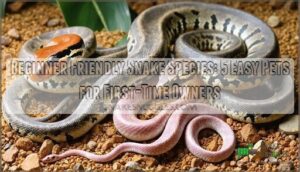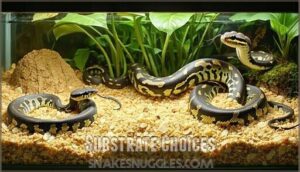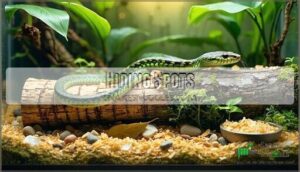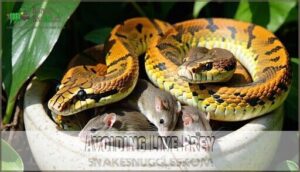This site is supported by our readers. We may earn a commission, at no cost to you, if you purchase through links.

These species offer forgiving temperaments, manageable sizes, and straightforward care requirements.
Corn snakes rarely bite and showcase stunning colors, while ball pythons curl defensively instead of striking.
California kingsnakes display bold patterns with calm dispositions, garter snakes adapt to various environments, and rosy boas stay compact with docile personalities.
Each tolerates minor care mistakes as you’re learning, requires basic temperature gradients and humidity levels, and thrives on frozen-thawed rodents.
The right choice depends on your specific lifestyle, local regulations, and long-term commitment to proper husbandry practices.
Table Of Contents
- Key Takeaways
- Beginner Snake Species
- Snake Care Requirements
- Feeding and Handling
- Unique Snake Behaviors
- Choosing Right Snake
- Frequently Asked Questions (FAQs)
- What is the friendliest snake to keep?
- Are snakes easy to take care of for beginners?
- What should I get for my first snake?
- What veterinary costs should I expect annually?
- How do snakes react to other pets?
- Can snakes recognize their human owners?
- What happens during snake breeding season?
- Are there snake insurance options available?
- Conclusion
Key Takeaways
- You’ll want to start with corn snakes or ball pythons – they’re the most forgiving species with docile temperaments that rarely bite, making them perfect for learning proper handling techniques.
- You’ll need to maintain proper temperature gradients and humidity – create a warm basking spot (85-90°F) and cool zone (75-80°F) with 40-60% humidity to keep your snake healthy and comfortable.
- You’ll save money and reduce risks by feeding frozen-thawed rodents – they’re safer than live prey, prevent injuries, and maintain nutritional value while being more convenient to store and handle.
- You’re making a long-term commitment of 15-25 years – research your local laws and ensure you can provide consistent care, proper housing, and veterinary attention throughout your snake’s lifespan.
Beginner Snake Species
Choosing your first snake doesn’t have to be overwhelming when you focus on beginner-friendly species that are forgiving and easy to handle.
These five snake species offer docile temperaments, straightforward care requirements, and manageable sizes that make them perfect starter pets for new reptile owners.
Corn Snakes
For beginners, corn snakes (Pantherophis guttatus) are the perfect starter species.
You’ll find these easy-to-care snakes incredibly docile, with temperament variations ranging from curious to calm.
Their stunning cornsnake morphs make choosing exciting, while breeding cornsnakes remains straightforward.
Basic enclosure enrichment keeps them happy, and health concerns stay minimal.
As beginner snake species go, corn snakes truly shine as the best snake for beginners seeking reliable companions.
To guarantee their well-being, remember to provide appropriate temperature gradients within their enclosure.
Ball Pythons
Ball pythons (Python regius) earn their reputation as top beginner snake species through their remarkably docile nature.
You’ll find captive breeding has produced stunning morph variations, from albino to pied patterns.
Temperament building happens naturally—these easy to care snakes rarely bite, and your enclosure enrichment should include proper hides since they ball up when stressed.
Watch for common illnesses like respiratory infections.
Garter Snakes
Garter snakes represent ideal starter pets for aspiring reptile enthusiasts.
These hardy North American natives adapt well to captivity and offer beginner-friendly care requirements.
Their docile snake temperament makes handling straightforward, while diverse garter morphs provide visual appeal.
Here’s what makes this snake species exceptional:
- Natural habitat adaptability – thrives in standard home enclosures
- Diet variety – accepts fish, worms, and rodents easily
- Conservation status – abundant populations guarantee ethical acquisition
- Co-habitation potential – some subspecies tolerate group housing
Their manageable 18-26 inch size suits most snake care setups perfectly.
California Kingsnakes
California Kingsnakes make excellent beginning-friendly snake species with their calm snake temperament once settled.
These hardy snakes require housing alone since they’re cannibalistic.
You’ll find various Kingsnake Morphs with striking black-and-white patterns.
A 20-gallon enclosure with proper enclosure enrichment keeps them content.
With good snake care, expect 12-15 years lifespan expectancy, making them rewarding long-term companions.
Rosy Boas
Desert-dwelling rosy boas make excellent beginnerfriendly small snake pets with their docile temperament and low maintenance requirements.
Their compact serpents rarely exceed three feet, featuring beautiful morph variations in pink, orange, and brown stripes.
Their wild origins in arid regions mean simple care needs, while their calm temperament traits make handling stress-free.
Secure enclosure security prevents their notorious escape artistry.
Snake Care Requirements
Once you’ve chosen your beginner-friendly snake, creating the right habitat becomes your next priority.
Proper care requirements aren’t just suggestions—they’re essential elements that directly impact your snake’s health, behavior, and longevity.
Enclosure Size
Your snake enclosure size directly impacts your pet’s health and happiness.
Adult corn snakes and ball pythons need minimum dimensions of 40 gallons (36"x18"x18"), while garter snakes thrive in 20-gallon tanks.
Consider your snake’s growth rate when planning – hatchlings start smaller but require upgrades.
Prioritize floor space over vertical space for most beginner-friendly species, allowing proper enrichment size and natural movement patterns.
A secure lid is essential to prevent potential snake escapes.
Temperature Gradients
Proper temperature gradients create the thermal zones your snake needs for healthy digestion and thermoregulation.
Your snake enclosure requires a warm basking spot and cooler retreat area, mimicking natural habitat conditions that allow behavioral temperature control.
Essential temperature gradient components:
- Basking Spot – Maintain 85-90°F using overhead heat sources like ceramic heaters or heat lamps
- Cool Zone – Keep temperatures around 75-80°F on the opposite enclosure end
- Thermostat Control – Use digital thermostats to prevent dangerous temperature spikes and maintain consistency
- Monitoring Temperatures – Install thermometers at both ends to track gradients and confirm species needs are met
Humidity Levels
Maintaining proper humidity levels keeps your snake healthy and comfortable.
Most beginner species need 40-60% humidity, measured with reliable gauges.
Low humidity causes shedding problems, while excessive moisture leads to respiratory infections.
Use misting techniques and water bowls for hydration methods.
Monitor levels regularly, adjusting as needed to prevent health issues in your pet, using reliable gauges.
Substrate Choices
Your snake habitat setup depends heavily on choosing the right substrate.
Aspen bedding works well for corn snakes and other species with burrowing needs, while coconut fiber maintains humidity for ball pythons.
Reptile carpet offers easy cleaning but limits natural behaviors.
Avoid cedar or pine shavings – they’re toxic.
Choose loose substrate that matches your snake’s natural environment and supports their health.
Many owners purchase quality aspen bedding for their snakes, considering the importance of a suitable environment for their pet’s well-being and the need for easy cleaning.
Hiding Spots
Your snake’s home needs secure hideouts that make them feel safe. Like having your own cozy bedroom, snakes require private spots to retreat when stressed or simply rest.
- Multiple Hides: Place one hide on the warm side and another on the cool side of your snake terrarium
- Size Matters: Choose hiding spots just large enough for your snake to curl up inside comfortably
- Naturalistic Hides: Cork bark, hollow logs, or commercial cave-style hides work perfectly for snake habitat setup
- DIY Hides: Empty yogurt containers or cardboard boxes make excellent temporary snake hiding spots
Snakes often require specialized reptile shelters to feel secure.
Feeding and Handling
Proper feeding and handling practices form the foundation of successful snake ownership for beginners.
You’ll need to establish consistent routines for both nutrition and interaction to keep your snake healthy and build trust between you and your new pet, which is crucial for successful snake ownership.
Frozen-Thawed Rodents
Frozen-thawed rodents offer the safest snake feeding option for beginners.
You’ll find proper rodent size prevents choking—choose prey no wider than your snake’s thickest body section.
Thawing methods include overnight refrigeration or warm water baths.
Nutritional value remains intact when frozen properly.
Storage safety requires airtight containers and rotation systems.
Prey variety isn’t necessary; consistency matters most for snake carnivorous diets.
To prevent bacterial contamination, always practice safe handling protocols.
Feeding Frequency
Throughout your snake’s life, feeding schedules change dramatically based on age considerations and growth monitoring.
Hatchlings need meals every 5-7 days, while adults eat every 10-14 days.
Prey size directly impacts frequency—appropriately sized food maintains steady weight without overfeeding.
During shedding periods, many snakes refuse food temporarily.
Track feeding dates to establish healthy dietary habits that support proper development, ensuring steady weight and proper development.
Handling Techniques
Gentle movements and patience work wonders during your snake’s acclimation period.
Start handling sessions short and gradually increase handling frequency as your docile snake breeds adjust.
Watch for signs of stress like defensive posturing or rapid breathing.
Safe restraint involves supporting the snake’s body weight while avoiding sudden movements, which helps keep both you and your nonaggressive snakes stay comfortable during interactions.
Avoiding Live Prey
Live prey poses serious risks that frozen-thawed rodents eliminate completely.
Prey injuries from bites and scratches affect up to 40% of snakes, creating ethical concerns about unnecessary suffering.
Frozen nutrition matches live prey quality while safe thawing at 98°F triggers natural feeding responses.
Many owners purchase pre-killed snake food for convenience.
Behavioral impacts include reduced stress and improved feeding schedules, making frozen-thawed rodents ideal for picky eaters.
Hygiene Practices
Proper snake hygiene protects both you and your pet from harmful bacteria and parasites.
Hand washing before and after handling prevents disease transmission, while regular enclosure cleaning maintains a healthy environment.
Water sanitation and quarantine protocols guarantee your snake’s wellbeing during shedding periods when snake safe interaction requires extra care.
- Clean hands save lives – washing prevents deadly salmonella transmission to your family
- Dirty enclosures kill dreams – poor snake cleaning destroys the joy of pet ownership
- Contaminated water breaks hearts – watching your beloved snake suffer from preventable illness
- Neglected shedding assistance crushes hopes – failing to help during vulnerable moments damages trust forever
Unique Snake Behaviors
Your snake’s behavior patterns reveal fascinating adaptations that help them survive in the wild.
Every snake movement tells a story of millions of years of evolution in action.
Understanding these natural behaviors will help you create a more comfortable environment and recognize normal versus concerning activities in your pet, which involves understanding complete concepts.
Defensive Mechanisms
When snakes feel threatened, they’ll display several defensive behaviors you should recognize.
Hooding behavior occurs when species like hognose snakes flatten their necks to appear larger.
Death feigning involves rolling over and playing dead, while musk release creates a foul smell to deter predators.
Stress coiling happens when ball pythons curl into tight balls.
Biting defense is their last resort, making proper snake handling essential for your safety.
Nocturnal Activities
When darkness falls, many snake species come alive with renewed energy.
Nocturnal hunting patterns define how your beginner-friendly species like ball pythons and woma pythons behave after sunset.
These snakes possess enhanced sensory adaptations including heat detection and improved night vision for successful predator avoidance.
Understanding their natural sleep cycles helps you provide appropriate snake care and manage their activity levels effectively, which is crucial for successful predator avoidance.
Burrowing Behaviors
Certain species naturally burrow underground, seeking cooler temperatures and safety from predators.
Kenyan Sand Boas and Western Hognose Snake (Heterodon nasicus) excel at nocturnal burrowing in sandy habitats.
You’ll need adequate substrate depth for tunnel stability – typically three to four inches of loose snake substrate.
This behavior aids temperature regulation and predator avoidance, making proper substrate selection essential for burrowing species’ wellbeing.
Stress Reduction
Understanding stress reduction creates a foundation for successful snake ownership.
You’ll need to provide hiding spots since darkness helps your best snake for beginners feel secure in their stressfree environment.
Maintain a quiet environment and respect handling limits to prevent snake stress.
Gradual acclimation builds trust while enclosure enrichment reduces anxiety, which is key to effective snake stress prevention, and following these snake handling tips guarantees a successful experience with your best snake.
Enrichment Activities
Beyond basic needs, enrichment activities transform your snake’s enclosure into a stimulating environment that promotes natural behaviors and mental well-being.
- Climbing structures like branches and platforms encourage exploration and exercise
- Puzzle feeders provide sensory stimulation and make mealtime more engaging
- Habitat variation with different textures and hiding spots mimics natural environments
- Regular enclosure rearrangement prevents boredom and encourages natural curiosity
Choosing Right Snake
Choosing the right snake species requires careful research to match your lifestyle and experience level with the animal’s specific needs.
Consider factors like adult size, lifespan, local regulations, and your ability to maintain proper temperature and humidity before making this long-term commitment.
Researching Species
Before you bring home your first pet snake, you’ll want to research each beginner-friendly snake species thoroughly.
Compare species temperament, handling difficulty, and size variance between corn snakes, ball pythons, and kingsnakes.
Factor in enclosure cost, lifespan commitment, and specific snake care basics for each option.
This research helps you select the perfect match for your experience level.
Owners should also consider snake temperament testing to find the best fit.
Considering Lifestyle
Your lifestyle shapes which beginner-friendly snake species will thrive in your home.
Consider these factors when choosing your pet snake:
- Space constraints: Smaller species like Kenyan Sand Boas need less room than Ball Pythons
- Time commitment: Easy care snakes require weekly feeding and monthly cleaning
- Family considerations: Choose docile species if children will interact with your snake
- Budget planning: Factor in enclosure setup, heating, and ongoing food costs
- Travel frequency: Snakes can go weeks without feeding, making them low-maintenance pets
Longevity Factors
Snake longevity depends on genetic predisposition, environmental enrichment, diet quality, veterinary care, and stress minimization.
Most beginner species live 15-25 years with proper snake care considerations.
Quality snake health requires consistent feeding schedules, regular snake veterinary care, and enriched habitats.
Your commitment to long-term snake lifespan responsibility means decades of care, making species selection vital for sustainable ownership.
Location Laws
Before committing to specific species, you’ll need to check the legal landscape. State regulations vary dramatically, with some jurisdictions requiring snake permits while others impose outright bans on specific snake subspecies.
Federal laws also apply to certain species. * Research Local Ordinances – cities and counties often have stricter rules than states
- Check State Regulations – permit requirements and banned species lists differ widely
- Verify Federal Laws – CITES protections may apply to certain subspecies
- Obtain Exotic Permits – many areas require licenses before purchase
- Review Banned Species – some beginner-friendly snakes face restrictions
Snake laws change frequently, so verify current regulations before making any commitments to ensure you are aware of the current regulations and can obtain the necessary exotic permits.
Environmental Factors
Your home’s environment directly impacts your snake’s health and behavior. Consider room temperature fluctuations, seasonal changes, and natural lighting when planning your setup.
Each species has specific requirements that you’ll need to accommodate year-round.
| Environmental Factor | Consideration | Impact |
|---|---|---|
| Room Temperature | Affects snake temperature regulation | Critical for digestion and activity |
| Natural Lighting | Influences day/night cycles | Important for naturalistic setups |
| Seasonal Changes | Alters humidity and temperature | Requires heating adjustments |
Enclosure ventilation prevents stagnant air while maintaining proper snake humidity levels. Your snake enclosure should account for your home’s heating and cooling patterns.
Quality snake substrate options help buffer environmental changes, creating stable habitat complexity that supports your pet’s wellbeing through varying conditions, ensuring a stable environment for your snake’s digestion and activity, and overall wellbeing.
Frequently Asked Questions (FAQs)
What is the friendliest snake to keep?
Over 60% of new snake owners choose corn snakes for their gentle temperament.
You’ll find corn snakes are consistently rated the friendliest pet snake species, combining docile handling with easy care requirements perfect for beginners.
Are snakes easy to take care of for beginners?
Yes, you’ll find snakes surprisingly manageable as pets.
They’re relatively low-maintenance compared to other animals, requiring simple weekly feedings and basic habitat upkeep.
Choose beginner-friendly species like corn snakes for easiest care, as they are often considered beginner-friendly.
What should I get for my first snake?
For your first snake, consider a corn snake or ball python.
They are docile, hardy, and forgiving of beginner mistakes.
You’ll also need a proper enclosure, heating, hiding spots, and appropriate substrate.
What veterinary costs should I expect annually?
You’ll typically spend $50-150 annually on routine vet checkups, with potential additional costs for treatments if health issues arise. Emergency visits can reach $200-
How do snakes react to other pets?
Snakes view other pets as potential threats or prey. You’ll need to keep your snake securely housed away from cats, dogs, and small animals to prevent stress or dangerous encounters.
Can snakes recognize their human owners?
Like a puzzle piece fitting snugly, your snake can distinguish you from strangers through scent and vibration patterns.
They’ll recognize your familiar handling style and chemical signature, though they won’t form emotional bonds.
What happens during snake breeding season?
During breeding season, you’ll notice your snake becoming more active and restless.
Males search for females, while females may refuse food and become territorial.
Hormonal changes trigger increased movement and mating behaviors, with hormonal changes being a key factor in this process.
Are there snake insurance options available?
You can get pet insurance for snakes through exotic coverage plans.
Companies like Nationwide offer reptile insurance covering medical treatments from licensed veterinarians, helping manage vet costs.
These plans offer similar coverage to traditional pet insurance, even including exotic pet conditions, covering various reptile needs.
Conclusion
Starting your snake journey is like choosing your first car—you want reliability, not complications.
These beginner friendly snake species profiles offer foolproof options for new reptile keepers. Corn snakes, ball pythons, California kingsnakes, garter snakes, and rosy boas each bring unique advantages while sharing essential traits: docile temperaments, manageable care requirements, and forgiving natures.
You’ll find success with any of these species when you provide proper housing, consistent temperatures, and regular feeding schedules.
Research local laws before purchasing, and remember that your snake will be a long-term companion requiring decades of committed care.


















